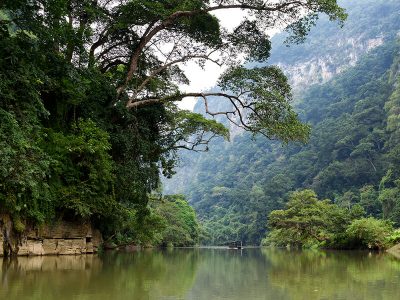
+84 343 470 507 info@theterribletourguide.com

Ba Be Lake is a freshwater lake located between Ba Be and Cho Don districts in Bac Kan province. The lake is 8km long, 3km wide, at a height of 145m above sea level and was formed more than 200 million years ago. Surrounding the lake are ancient limestone mountains dating back over 450 million years. This place is recognized as a national tourist area in Vietnam.
In the local language, Ba Be Lake is “Slam Pé” (three lakes), which is the common name of three interconnecting lakes: Pe Lam, Pe Lu and Pe Leng. Ba Be Lake was formed more than 200 million years ago, due to the creation of the Southeast Asian continent at the end of the Camri era, which brought a huge amount of water with a surface of approximately 5 million m2 and a thickness of more than 30m on the middle of the. Limestone mountain, creating Ba Be Lake.

The greatest value of Ba Be Lake is the unique geological landscape. According to geologists of the Geological Institute of Vietnam and the Belgian Geological Association, limestone in the Ba Be Lake area dates back to 450 million years with very special tectonic characteristics. Because in the process of geological transformation, limestone in this area has turned into granite patches. Along with that, the bottom of Ba Be Lake has a covered layer of clay up to 200m thick, this clay stratum itself does not allow water to drain and the lake is formed.
The outstanding value of the lake is biodiversity. This is the largest natural freshwater lake in Vietnam. Ba Be Lake has a length of over 8km, the widest is about 3km, it’s about 20 to 30m deep. The lake is 145m above sea level, the lake surface is about 500ha, surrounded by limestone mountains with many underground streams and caves. The part between the lakes is slightly waist. There are two small islands in the middle of the lake (An Ma island and Ba widong island). Around the lake is a complex of tourism areas such as Ao Tien, Po Gia Mieu island, Puong cave, Dau Dang waterfall … In addition to the values of landscape and geology, Ba Be Lake is also home of about 50 species of fresh water fish, including very rare fish such as Ba Be toad fish, Giant Devil Catfish, blue mackerel… and many rare and precious plants named in the Vietnam Red Book such as Burretiodendron hsienmu, Polyscias fruticosa, Iron-wood, Phyllostachys…
There are 3 main streams flowing into Ba Be Lake, from Cho Lung River to the lake at Pac Ngoi village; Nam Cuong stream flows from the north of Cho Don district into the lake at Bo Lu village and Ta Han river originates from Xuan Lac and flows into the west of the lake in Coc Toc. The amount of water in Ba Be Lake changes in the rainy season and the dry season, the difference between the two seasons ranges from 1 – 2m deep, becoming the water regulation place for Nang River from Be Cam estuary. Thanks to the surrounding lakes, rivers, streams, mountains and forests, Ba Be Lake water has an annual average temperature of about 22oC, Warm in the winter, cool in the summer.

Coming to Ba Be Lake, visitors can sail around the lake with a dugout wooden canoe of indigenous peoples or by modern boats watching many natural sights.
With many unique features and beautiful natural landscapes, in March 1995, Ba Be Lake was recognized as one of 20 special freshwater lakes in the world by the World Freshwater Conference in the United States and need to be protected and developed. March 13, 1977, Ba Be is recognized as a scenic spot and historical site. On September 30, 1996, Ba Be Lake was recognized by the Ministry of Culture and Information as a cultural and historical relic. At the end of 2004, Ba Be National Park was recognized as an Asean heritage, especially of Ba Be Lake – one of the largest natural freshwater lakes in Vietnam, which has been recognized as a cultural and historical site. country in 1996.
The lake is 18km from Cho Ra town (Ba Be district). From Bac Kan town, we can go to Ba Be lake in 2 ways: go along the provincial road 256, from Bac Kan town to Ba Be, more than 60 km long; or follow the provincial road 257 from Bac Kan town to Cho Don and continue to Ba Be about 70 km long.
|Read more: Ba Be National Park Highlights & Travel Guide
